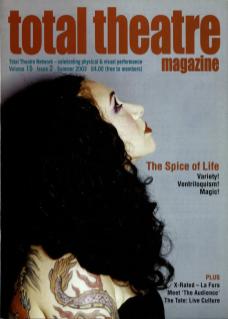The first thing that struck me as Abramovic took the stage was her glamorous beauty – partly genetic but mainly to do with the bearer's own connection to inner vitality or creative source, as if beauty comes to those who dare to look 'truth and all its accompanying demons' in the proverbial eye. Abramovic – with over 30 years experience of making performances that explore the physical limits of the body in order to eliminate fear and to take charge over the experience of pain – looked as fresh as a daisy.
'I am going to be like a disc jockey,' she said as she asked for the auditorium lights to be dimmed so she could begin showing her collection of 'all-time favourite' video clips.
The lecture was a kind of 'desert island clips' of 'how the body can be used in performance' accompanied by a non-stop monologue describing her personal take on performance art, spirituality, the art business, fashion, cutting yourself, pain, the mind, life and love since the 1960s. Her speech was littered with one-liner gems that encapsulated her personal motivation (and became food for the hungry performance art ghosts in the auditorium).
‘When you are chopping vegetables or doing some menial task and you are suddenly gripped by an idea that terrifies you and makes you panic, these are the ideas that you should follow.'
‘The public are like a dog – they can smell fear... So you must control your fear... You must be like Maria Callas and have half your brain under control focusing on the task and the other half loose and ready for anything.'
‘Performance is mental and physical construction, an energy exchange, nothing to do with theatre, in live art there is no repetition, you take it as it is.'
These statements rang of show(wo)manship, we were in the company of a shape shifter, a magician who takes reality and momentarily reshapes it...
The video clips shown included examples from her own and others' work, divided into 'body part' sections. In 'Head' was one in which Abramovic repeatedly brushes her hair whilst saying ‘the artist must be beautiful, art must be beautiful'. Repetitive, dramatic and theatrical – and nowadays the kind of performance action that is often found within the territory of theatre!
There were clips from Pina Bausch (tangoing feet) and performances by Marina Abromavic and her long-term life and performance partner Ullay. The first Ullay/Marina piece showed them standing naked in front of two moveable pillars. The performance involved them running at the pillars and pushing them along with their chests. This performance lasted about three hours despite the bruises inflicted to their bodies, the inevitable physical exhaustion and the protests from the audience who were at times begging them to stop. There was also a remarkable clip in which a video camera had been attached to a performer's bare chest to record the events as she ran on all fours like an animal through a forest whilst the audience pursued her like hounds. The camera showed the performers' arms, dangling breasts and the ground blurring along to a soundtrack of panting and running.
One section of video clips was entitled ‘the performing body' and contained clips from performance that goes beyond that which is 'scripted' by the artist into that which seems to be a state of 'oneness' or 'grace' – audience and performer united in one single focus in time.
This idea was illustrated by a clip from a live TV transmission of the Pope addressing the Youth of America in Madison Park gardens. During his visit the Pope was asked to make an address to his audience. As he took his place to speak, the young crowd became excited and began to cheer him as they would a popstar. The applause and whistles went on endlessly – when the noise died down in one place it was picked up in another and the cheering became a constant relay around the auditorium. The smiling Pope was obviously entertained by this adoration and seemed not to want to speak over it, so began to make a high pitched whirling noise, a kind of gentle wolf-whistle that matched it. This led to an ecstatic exchange of cheers/wolf-whistles between the Pope and the audience, that united them in one idea and excluded all other observers (even the Cardinals, who became extremely agitated). The Pope / Youth of America exchange went on for what seemed like at least 20 minutes before his Holiness leant forward and said, 'We are going to get this programme cut' – at which point the programme was cut by the TV channel.
Abramovic has the stance of being the doyenne of performance art (and she keeps good company and tells a good tale). If there had been time for questions and answers at the end of the lecture I would have liked to have asked her, among other things, if her lecture had been rehearsed and therefore was it live art or theatre? Somehow I felt that it veered toward the latter, but as we were in the company of an artist so totally involved in the art/life/performance matrix there was no longer a distinction.
